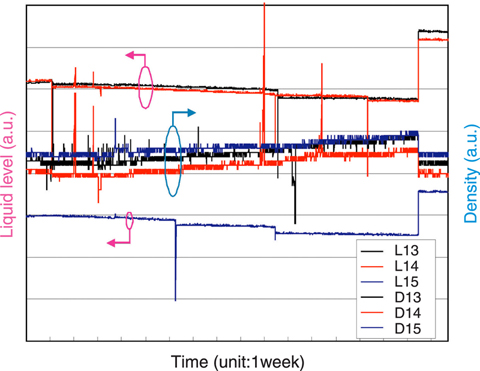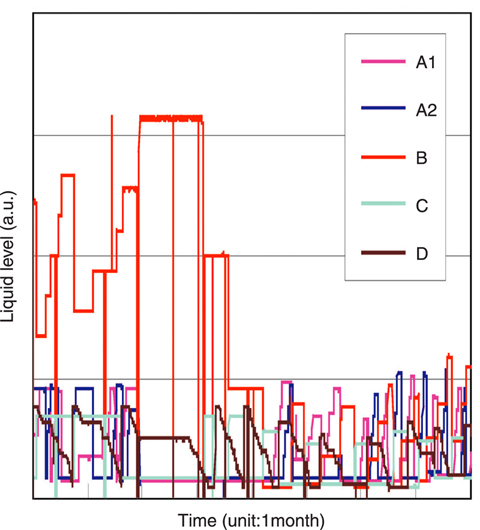
Fig.13-2 TRP Tank Data

Fig.13-3 SRS Tank Data
In contrast to the handling of operation data for maintenance of safety, safeguards against deliberate unauthorized transfer of radioactive material by facility staff are insufficient. Process monitoring (PM) to detect malicious diversion and misuse started in the 1970's, and introduction of PM into IAEA safeguards has been proceeding with caution.
The objective of IAEA safeguards is to detect a significant quantity (SQ) (=8kg Pu) loss in a timely fashion (within 30days). Since a statistical test depends on a known probability distribution, the most sensitive such detection of material unaccounted for (MUF) in a specified period cannot identify the time of loss within that period. Some sequential tests have been developed to meet the timeliness target even when throughput increases. Although the most powerful test for any type of loss lacks precision, a near-real-time accounting (NRTA) method is widely accepted for the interim accounting.
A solution monitoring system (SMS) with liquid level, density, and temperature in the solution tank in a reprocessing plant being measured is a typical example of PM. Real data of Tokai Reprocessing Plant (TRP) is shown in Fig.13-2 and data of Savannah River Site (SRS) in USA in Fig.13-3. A consistency check comparing the declared and the actual levels and recognizing any abnormalities during the solution transfer is an important role of SMS. Currently SMS is installed in Rokkasho Reprocessing Plant (RRP) to complement the IAEA safeguards.
In this study, we intend to demonstrate the benefit of PM quantitatively and to pursue its application as a NRTA substitute. To avoid more frequent accounting to meet the timeliness constraint even if the measured MUF exceeds1 SQ without waiting 30days, several candidates such as quantified C/S, loss accounting by PM, and less frequent NRTA were investigated.
Because the PM study was started first in the U.S. and some researchers there had been already working on this in accordance with internal DOE and NRC regulations, we are studying SMS application and evaluation using TRP and SRS data in a two-year joint project with Los Alamos National Laboratory (LANL). Up to now it has been found that after simulating a hypothetical removal of liquid with real tank data, multivariate statistical analysis considering loss due to evaporation accurately determines the amount of the removal based on level decrease and density increase. Moreover, we demonstrated that the event monitoring detects wait and transfer modes, and investigated the effect of time variation on detection probability of abnormal changes in the nuclear material quantity. We are striving for results that will be useful for future IAEA safeguards.
<Previous: 13 Scientific & Technical Development for Nuclear Nonproliferation | Next: 14 Development of Experimental Techniques / Facilities at JAEA R&D Centers >